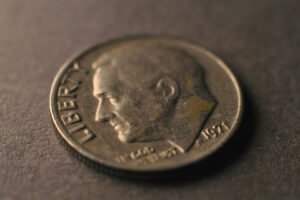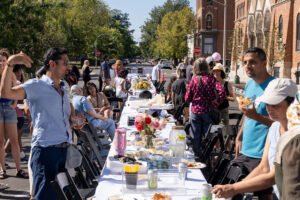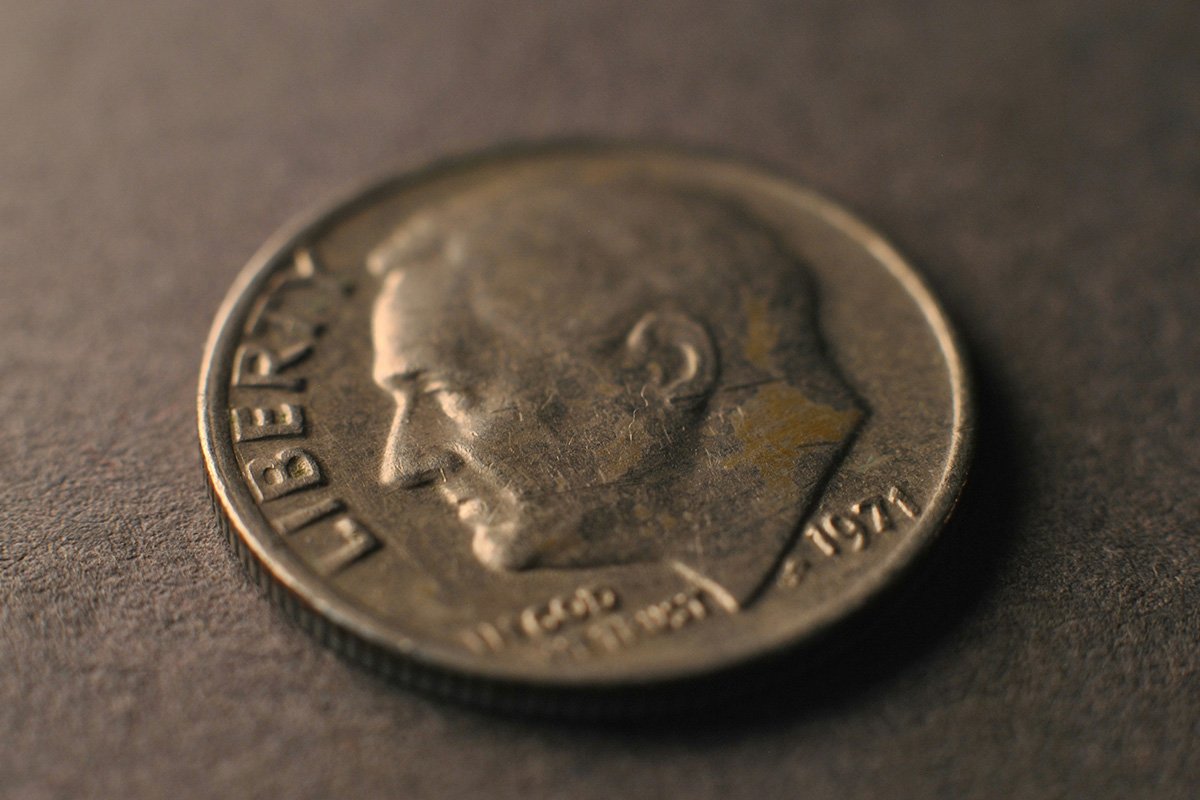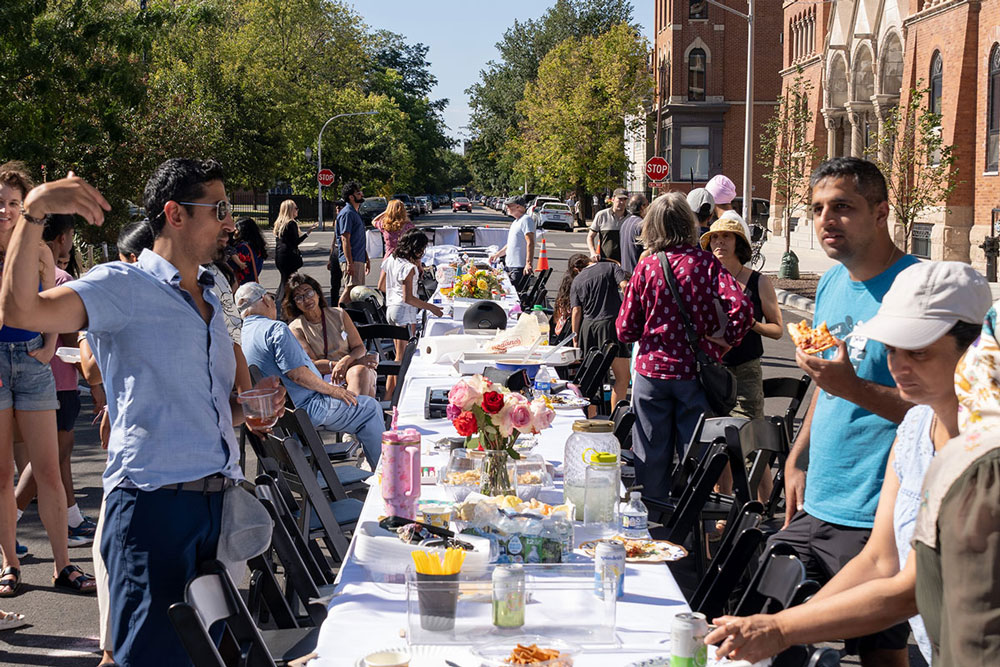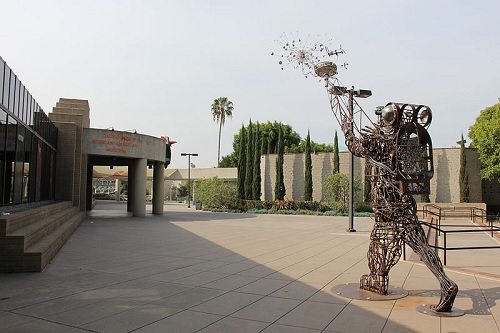
Editor’s Note: This is the second of a two-part series on how African-American museums in the U.S. are faring amidst the competition for foundation, charitable, and governmental resources. Part I was an overview of the issues and challenges facing black museums; this piece examines the sources of funding and the strategies that some museums are using to survive and thrive.
This nation’s white-dominated history leaves most Americans ignorant about many of the contributions of African Americans—not the famous examples of scientists like George Washington Carver and Benjamin Banneker or today’s panoply of celebrities, but the day-to-day efforts of African Americans settling and creating communities across the nation. Museums that collect, preserve, and honor the history and culture of African Americans play an important role in educating all Americans about a crucial part of the nation’s history and people. Many black museums face significant financial challenges, but that hasn’t stopped people in communities small and large from attempting to get museums established and operating.
Once the plantation of William E. Kendall, who subdivided and sold his property to former slaves, Kendleton, Texas is a town of less than 400 residents according to the 2010 Census. Larry Callies, who has a shop in Kendleton where he makes leather cowboy accessories, announced a plan recently to establish a museum to honor the history of black cowboys from Texas. Callies hopes to have the museum open by Juneteenth next year—June 19th, the date commemorating the end of slavery in the United States, specifically the landing of Union soldiers in Galveston, Texas announcing the end of the Civil War more than two years after President Lincoln’s Emancipation Proclamation.
While Callies attempts to raise money for his small museum, where he hopes to display photographs of black cowboys from the 1890s to the 1960s, in Atlanta, Mayor Shirley Franklin proclaimed the opening of a new 43,000 sq. ft. $103 million civil rights museum. Atlanta is a big city with substantial resources to draw on, including the headquarters of such corporate behemoths as Coca-Cola, Delta Airlines, Home Depot, and United Parcel Service, iconic African-American institutions such as Spelman College and Morehouse College, and a historic connection to Martin Luther King Jr., who co-led Ebenezer Baptist Church and is buried in the Sweet Auburn neighborhood. Atlanta hopes that the new Center for Civil and Human Rights will reclaim the city’s central place in the nation’s civil rights history and capture a large part of civil rights tourism.
The draw would be Dr. King’s history in the city, but the King family has been engaged in unseemly internecine legal warfare over who controls Dr. King’s documents and the larger related question of the civil rights leader’s intellectual property rights. The Martin Luther King Jr. National Historic Site, run by the King family, has seen annual visits plummet from 3.3 million in 1992 to 704,000 in 2013. Atlanta’s new civil rights museum will be competing with civil rights museums in Memphis (where Dr. King was assassinated), Birmingham (the epicenter of violent resistance to civil rights activists and where Dr. King wrote his call for nonviolence, Letter from a Birmingham Jail), and Greensboro (where four North Carolina A&T students sat in at the Woolworth’s segregated lunch counter and refuse to leave), plus a new civil rights museum scheduled to open in Jackson, Mississippi in 2017 (recognizing, so to speak, the terrible civil rights history of the state that includes the assassination of Medgar Evers and the murder of civil rights volunteers James Chaney, Andrew Goodman, and Michael Schwerner)—and next year’s planned opening of the National Museum of African-American History and Culture on the National Mall.
Larry Callies’ Kendleton museum may be as much a project of love and commitment as it is a business venture, likely to operate for as long as Callies and his neighbors choose to make it work. Atlanta’s Center for Civil and Human Rights, on the other hand, needs according to CEO Doug Shipman 350,000 visitors a year (with projected admission fees of $15 per person) to break even.
Other national civil rights museums like Atlanta’s have also on occasion faced financial challenges. The National Slavery Museum associated with former Virginia governor Doug Wilder declared bankruptcy after failing to raise sufficient money to build the facility and pay taxes on its Fredericksburg, Virginia site. Greensboro’s International Civil Rights Center and Museum has run a $400,000 annual deficit since it opened in 2010 and defaulted on a $4 million loan. Mayor Franklin and Shipman have high hopes for their museum, but it will not be an easy path to financial sustainability.
Financial Strategies for Black Museums
Will Kendleton’s museum make it? Will the Atlanta Civil Rights center prove competitive? What will it take to make them more financially robust and competitive, given that many of their peers—and many small museums of all sorts—have had challenges in navigating the financial challenges of limited charitable giving during the years of the Great Recession?
Based on NPQ’s identification of dozens of African-American museums, Woods Bowman, professor of public service at DePaul University in Chicago and previously Chief Financial Office of Cook County, Illinois, prepared an analysis of 14 of them compared against a peer group of comparable cultural and historical museums in their regions with revenue and expenditure data for the period of 2007 through 2011. Although Bowman attempted to select a peer group that was relatively comparable in size and scale to the 14 African-American museums, the match proved difficult. In the end, the non-African-American peer group had revenues 20 percent greater than the African-American museums and assets per dollar of expenditures twice as large. That observation of Bowman is instructive in and of itself. Even when constructing an analysis of African-American museums with a reasonably comparable peer group of other museums, the African-American museums were significantly less wealthy. Consequently, only six of the African-American museums had assets invested in securities compared to nine of the peer group museums.
“In 2007, philanthropic contributions and government grants to African-American museums amounted to 82 percent of their total revenues,” Bowman observed. “By 2011 philanthropic contributions to African-American museums had been more than halved.” In 2007, prior to the beginning of the recession, the 14 African-American museums were more dependent on philanthropic support than government grants, but by 2011, that was reversed and more: Government grant support for the African-American museums exceeded philanthropic support by more than 200 percent. Even with that proportional shift toward greater reliance on government dollars, eight of the 14 African-American museums saw their government revenues decrease between 2007 and 2011.
The 14 African-American museums in Bowman’s analysis are museums that survived and had five years of financials to show. Without a random sampling of African-American museums, it would be impossible to suggest that a majority or all African-American museums followed the trajectory of these 14. However, for surviving the years of the recession, these 14 African-American museums turned to “increased government support and new special events [that] nearly offset philanthropic losses,” according to Bowman.
Bowman added a postscript on this strategy: “I believe their future holds greater uncertainties due to increased dependence on fickle government support.” When does success in attracting a revenue source turn into dependence? It is fundamentally a matter of revenue diversification. Although making an anecdotal observation, Bowman noted that “substantially fewer African-American museums [compared to the peer group museums] reporting income from sources other than philanthropic contributions and government grants.”
While several of the African-American museums did their best to cut expenses faster than revenues were falling or embarked on new money-making ventures such as new program services, special events, and selling gifts and souvenirs, they were still as a group increasingly dependent on governmental funding and able to draw on little more than government and philanthropy going forward. Generating program revenue requires expanding program offerings to reach a diverse audience, perhaps more diverse than the African-American constituency that helped create the museums, but to that end, these museums are competing with their non-African-American or even Eurocentric peers for content and substance that will attract paying visitors.
Show Us the Money
Mayor Joe Riley of Charleston, South Carolina traveled to New York in June to pitch the International African American Museum for private foundation and corporate funding, meeting with representatives of Morgan Stanley, the Doris Duke Charitable Foundation, and former president Bill Clinton. Riley needs $25 million in private funding and plans on counting on $50 million in public funding—but only $25 million of the public moneys have been approved to date by the city, county, and state.
Mayor Riley is trying to get Charleston’s museum started, but in Detroit, the nation’s largest African-American museum, the Charles H. Wright Museum of African American History, is struggling. Owned by the city (like the Detroit Institute of Arts), the Wright’s funding from the city has dropped 63 percent in recent years. Its budget has shrunk from $6.4 million in 2009 to $4.7 million this year, and is anticipating running a $200,000 deficit this year as it did last year. With the help of capacity-building grants from the Ford Foundation, the Kresge Foundation, and the John S. and James L. Knight Foundation, the Wright is working on a new strategy to generate income through enhancing new programs, generating a stronger coterie of potential individual donors, and recruiting top flight staff for fundraising and development.
The museum is aiming to bring revenues and budget levels back to their 2009 levels. “The museum, and its role in the community, is too important to continue simply fighting for survival, year in and out,” the Wright’s CEO, Juanita Moore, told Crain’s Detroit. “We don’t have a spending problem, we have a revenue problem.” Toward that end, the Kellogg Foundation recently announced a $1 million grant for the Wright, but the most interesting grant in recent months was the $100,000 from local businessman Jon Barfield, who said he has moved by the donation of A. Paul Schaap of $5 million for the DIA to help the museum’s art collection as well as public employee pensioners.
Due to political sensitivities, most people, unlike Barfield, have steered clear of comparing what the city and its philanthropic and other leaders have done to help the DIA with they might or should do for the Wright. As much as Detroit’s future hinges on protecting the DIA collection from being parceled off to generate one-shot revenues for the bankrupt city, the future of Detroit, a majority African-American city, would be harmed in some measure or another by the loss of a major African-American institution like the Wright.
The Wright’s physical plant, difficult and expensive to operate, may constrain some of that museum’s financial options, but others are thinking creatively about public resources as well as private options. In Pittsburgh, yet another troubled African-American museum is facing a need for a disruptive business plan. The long troubled, now bankrupt August Wilson Center for African American Culture has an offer on the table from a New York based real estate development firm to purchase the museum for $9.5 million. The developer would like to place a 200-room hotel on top of the museum, with no apparent guarantee that the museum would remain a museum.
After unsuccessful efforts to secure funding for the August Wilson Center from Pittsburgh’s rich array of foundations such as the Heinz Endowments, the McCune Foundation, and the Richard King Mellon Foundation, the conservator of the museum recommended that the facility be sold off to pay off its mortgage and other debts totaling roughly $9.5 to $10 million. It doesn’t seem totally surprising that the developer’s bid for the site is also $9.5 million. The Urban Redevelopment Authority recently intervened to have the bankruptcy judge consider requiring that the developer pledge to maintain the facility as a museum, but that doesn’t necessarily mean an African-American museum, nor that the city, itself facing its own severe financial strains, is in any position to intervene to provide funding for the museum as an African-American institution as envisioned by community leaders.
African-American Museums in the Future
The August Wilson Center wasn’t always a downtown museum. Its origin was as the Homewood Art Museum in the largely African-American neighborhood of Homewood. The co-founder of the Homewood museum, artist Emma Slaughter, opposed the idea of creating a new downtown museum and merging her museum into it, an idea that seems to have gestated in the planning associated with the NAACP national convention held in Pittsburgh in 1997. Slaughter wanted an African-American cultural center, as conceptualized by the NAACP’s local chapter, to remain in an African-American neighborhood.
August Wilson himself grew up in the Hill district of Pittsburgh. The fancy $40 million downtown building doesn’t seem to fit the two-time Pulitzer Prize-winning playwright who preferred to do his writing in restaurants, coffee shops, and bars, often scratching ideas on cocktail napkins and paper tablecloths. Slaughter has never visited the downtown facility and is reportedly unsympathetic to the museum’s financial troubles.
Are there lessons from the Wright, the August Wilson, and other museums, those that are troubled as well as those that are charting paths toward sustainability? Our sources suggest that there are:
Maintaining their roots: While programming may have to broaden to appeal to wider audiences who should experience and learn about black history and culture, as demonstrated by many institutions, African-American museums have a definable constituency that can and should be dedicated to their sustenance and growth. Notions that the African-American community is unreachable and cannot be motivated to support black museums are simply not borne out when the museums do what is necessary to connect to their community constituencies and strengthen those relations. It is certainly admirable that Mayor Joe Riley seems to be integrally involved in the Charleston museum effort and that former Mayor Tom Murphy was instrumental in helping bring the August Wilson center to life, but these institutions cannot and should not lose their community roots—even as they reach out to broader audiences and political supporters.
One-fifth of all revenues supporting arts and museums come from individual donors. Individual giving is coming back from the depths of the recession and giving of all kinds to arts and culture is up significantly, but are African-Americans giving? A report by Rockefeller Family Advisors and the W.K. Kellogg Foundation suggests that two-thirds of black households are donors to charitable causes, 25 percent more generous than white households in terms of the proportion of income they give, amounting to some $11 billion in 2010. The charitable generosity of African-Americans is reflected, in the Kellogg/RPA study in the growth of grantmaking funds with specific African-American orientations and priorities.
The Kellogg/RPA study counted 303 “identity” funds, 75 of which were classified as African-American, outnumbered only by the 87 women’s funds. While allowing for funds with multiple purposes, only 12 of the 75 African-American funds included the arts as one of their giving priorities, compared to 54 for education, 34 for economic empowerment, 24 for health, and 19 for children and youth. It isn’t difficult, however, to imagine the programs and functions of black museums fitting into the other giving categories of these black funds—education, empowerment, children—which may very well mirror the secular giving priorities of black households in general.
Larger establishment or white museums have traditionally been beneficiaries of some of the big grants that major donors typically make. Are big donations in the cards for small, local black museums? While there are givers in the black community, like Oprah Winfrey, the reality is that the black community doesn’t possess asset wealth comparable to its share of the population. In an analysis by John J. Havens and Paul G. Schervish from more than a decade ago that undoubtedly holds true today in its larger ramifications, while constituting 12.4 percent of all households, African-American households will account for less than 2.5 percent of the intergenerational transfer of wealth.
The implications are powerful. If the African-American community of this nation is going to educate others about the centrality of race in American history and the importance of African-American culture in the past and going forward, while there may be benefactors of the size and scale of Oprah, the ultimate success of fundraising for black museums may be in connecting with and mobilizing large numbers of African-American charitable givers and not waiting for seven-figure grants from Oprah. And that means positioning black museums not as institutions in a silo of art, separate from other institutions and functions in the community, but as integral providers of services and programs in education, economic empowerment, children and youth, and women and girls. As summarized by museum professor Redell Hearn, “you can’t sustain [African-American] museums without a commitment from the community of the museum, the community whose stories are being told.”
Government engagement: Two-thirds of the funding for the Charleston museum has to come from public sources if that museum is going to be realized—and the resources are from state and local government. The Charles H. Wright museum has long been dependent on funding from the city of Detroit—and lives in a city-owned building. As Bowman’s analysis makes clear, even if the black museums step up their philanthropic fundraising apparatus, there is no way of getting around the necessity of public funding. In other countries, museums of all sorts are viewed as public or quasi-public assets. That is the challenge in the U.S. overall and specifically for black museums. Race, or the struggle against racism, has been central to America’s history of social inequities. Bringing that national history down to local community levels through arts, culture, and history institutions makes black museums that examine and address race assets of public importance. It is why the new National Museum of African American History and Culture being built on the National Mall is a serious part of the Smithsonian apparatus and not a kitschy, for-profit entertainment center.
Unfortunately, government funding for arts and museums has been on a steady decline in recent years—and in general has been a small part of arts and museum funding. A 2012 study from the National Endowment of the Arts estimated government funding as a proportion of all revenues of performing arts and museums at 6.7 percent. Foundation funding was larger than all government funding combined at 9.5 percent (corporate donations constituted an additional 8.4 percent). If black museums are going to rely on contributed income, the largest source reported by the National Endowment of the Arts is giving by individuals, comprising 20.3 percent of performing arts and museum revenues. The contributed side of the revenue picture is critical for black museums in general, as the other major sources of revenues—earned income (40.7 percent) and interest and endowment income (14.4 percent)—may not be easily generated in the former and perhaps next to impossible given black museums’ limited assets in the latter.
Like the to-be-built museum in Charleston, state funds are a potential target for black museums. Beyond what might occur in state legislatures as special appropriations for museums like Charleston’s, one measure for gauging potential state government funding for black museums is the money available to state arts agencies. Overall, according to a report from the National Assembly of State Arts Agencies, four out of five state arts agencies posted revenue increases between 2013 and 2014, reflecting the improved fiscal picture of most states coming out of the recession. However, a one-year increase doesn’t undo the long-term decline in state appropriations for arts agencies—down 31.7 percent since 2001 or 48.2 percent in inflation-adjusted dollars.
Taken by state, some states are strong in their per capita as well as total state arts agency funding for Fiscal Year 2014, and some are distinctly lagging:
|
Top Ten States (and 2010 Afr. Amer. population) |
Total State Arts Agency Revenue Per Capita |
Per Capita Funding Rank |
Bottom Ten States (and 2010 Afr. Amer. population) |
Total State Arts Agency Revenue Per Capita |
Per Capita Funding Rank |
|
Minnesota (4.57%) |
$6.45 |
1 |
Georgia (30.2%) |
$0.15 |
50 |
|
Delaware (20.95%) |
$4.33 |
2 |
California (6.67%) |
$0.18 |
49 |
|
Hawaii (3.08%) |
$4.18 |
3 |
Texas (11.91%) |
$0.25 |
48 |
|
Wyoming (1.29%) |
$3.27 |
4 |
Kansas (6.15%) |
$0.26 |
47 |
|
Vermont (0.87%) |
$3.18 |
5 |
Wisconsin (6.07%) |
$0.27 |
46 |
|
Maryland (29.44%) |
$2.77 Sign up for our free newslettersSubscribe to NPQ's newsletters to have our top stories delivered directly to your inbox. By signing up, you agree to our privacy policy and terms of use, and to receive messages from NPQ and our partners. |
6 |
Washington (3.74%) |
$0.45 |
45 |
|
Alaska (4.27%) |
$2.54 |
7 |
Arizona (4.16%) |
$0.49 |
44 |
|
Rhode Island (6.36%) |
$2.21 |
8 |
Virginia (19.91%) |
$0.54 |
43 |
|
Montana (0.67%) |
$2.16 |
9 |
Indiana (9.07%) |
$0.55 |
42 |
|
New York (15.18%) |
$2.07 |
10 |
Florida (15.91%) |
$0.58 |
41 |
Sources: National Assembly of State Arts Agencies, February 2014 and U.S. Census 2010
Although Mayor Franklin may be successful in promoting the civil rights museum in Georgia and attracting state funding, the availability of state arts dollars for black museums is in all likelihood subject to a scrum based on the merits of proposals and the political influence of the applicants.
The Institute of Museum and Library Services estimated in 2007 that there were 17,744 museums in the United States. In a sample of museums examined for IMLS by the Urban Institute, art museums and history museums, the two predominant kinds of museums reflected in the list of black museums examined by Bowman, are in general much less dependent on government revenues than those Bowman reviewed:
|
Type of Museum |
Private Support (%) |
Support from Earned Income (%) |
Investment Income (%) |
Support from Government (%) |
|
All Art Museums |
23.3 |
46.1 |
17.5 |
13.1 |
|
Art Museums excluding public museums |
23.0 |
48.1 |
18.5 |
10.4 |
|
History Museums |
32.9 |
21.6 |
13.2 |
33.2 |
|
History Museums excluding public museums |
46.0 |
23.5 |
21.4 |
10.3 |
|
All Museums (incl. children’s, science, zoos, arboretums, etc.) |
24.4 |
43.7 |
12.2 |
19.7 |
Source: Adapted from Urban Institute analysis, IMLS Museum Public Finance Survey, 2008
Factor out public museums, and the result is that most museums receive a relatively small proportion of their revenue from governmental sources. The IMLS notes that there is hardly a consistent mechanism from state to state as to how legislatures distribute government funds to museums. States often require matching funds from museum applicants, which leaves many smaller museums on the outside of governmental funding. Given restricted state budgets, even with the upturn in state revenues, states are typically asking museum applicants for self-sufficiency plans that emphasize earned revenues, much like the strategy that is being developed for the Wright in Michigan, but that is also a tough challenge. According to Mindi Love, the director of the Johnson County Museum in Shawnee, Kansas, as quoted in the IMLS study, “The cost to operate a museum and serve our visitors is far higher per person than the revenues generated by most museums. The median cost of serving one museum visitor is $23, compared to the median revenue earned of $6 per visitor.”
The largest source of governmental revenues for arts museums is local government (52.5 percent) and for history museums state government (43.0 percent). That would suggest that most museums are hardly going to get much in the way of revenues from federal competitive grant sources much less increasingly anachronistic federal earmarks. The challenge for black museums is this: for sustainability, they must make the case to local and state government that they bring a value to the public that warrants their being supported from local and state revenues.
While black museums, even the vaunted Wright, may need to rely on government funding for a long time in the future, they are unlikely to be beneficiaries of special guaranteed revenue streams such as the millage assessment of property owners in three metropolitan Detroit counties supporting the Detroit Institute of Arts. They are too small and too specific in their art or history niche. But, they have to demonstrate to taxpayers that they are critically important institutions in their localities’ and states’ public space. Like the big, Eurocentric museums, black museums have to present themselves as entirely appropriate and logical beneficiaries of revenues from hotel and lodging taxes, sales taxes, and property taxes. They must be presented to the public as public assets, even if they are nonprofit owned and managed, contributors to the identity and prosperity of their communities and states, with value returned far greater than the taxpayers’ outlays.
“It’s about advocacy,” Dr. Schroeder Cherry, a longtime veteran of black museums, told NPQ. “When you’re dealing with public money, you have to somehow convince your legislators that what you’re doing is worthy of sustainability.” That is the challenge for the Wright or any African-American museum—explain to the public why an appreciation of African-American art, culture, and history is a public benefit and therefore a public (or taxpayer) responsibility.
Partnerships among institutions: Collaboration is the buzzword that almost everyone voices and few practice, but occasionally examples that look legitimate and real show up. Among the more than 1,700 grants focused on black men and boys counted by BMAfunders.org, a project of the Foundation Center and the Open Society Foundations, relatively few seem to have gone to museums, much less black museums. Of the 170 or so that were listed in as grants in the arts, however, 53 went to the Washington, D.C.-based Life Pieces to Masterpieces, which provides opportunities for black men and boys living largely in public housing to use artistic expression as a means of education and development. Although the organization is looking to establishment a permanent location, Life Pieces uses space in Washington, D.C. public schools and often conducts shows and seminars in other institutions. Even if Life Pieces succeeds in raising enough money to acquire a permanent home in the expensive Washington, D.C. real estate market, the collaboration with the schools—and with local universities—points to an important potential pathway of success for black museums, collaborating with schools and other public sector institutions.
The IMLS report actually makes a big point about museum partnerships with the educational system:
“As centers of learning in communities, museum partnerships with schools provide valuable curriculum support to K–12 education, engaging children of all ages both within the museum and out in the community. It is estimated that museums in the United States provide millions of instructional hours per year to students, through programming that spans the range of museum type, location, and student grade level. Museum education services are delivered in a variety of ways, including on- and off-site activities with museum staff, teachers, and students; pre- and post-visit lessons; and educational programs that support school curriculum standards and learning objectives. Museum-school partnerships offer unique and exciting programs that extend beyond traditional curriculum and formal education models to create a collaborative network of learning approaches and environments that enhance K–12 education and set the foundation for lifelong learning habits.”
The IMLS report also underscores the potential of partnerships among museums themselves. Marc Wilson, director of the Nelson-Atkins Museum of Art in Kansas City, describing large museums as “centers of excellence and capability,” was cited in the IMLS report to say, “In my view, we have failed to employ these centers of capability to serve as agents of improvement for smaller institutions that reside in the service regions of the large institutions…This is not a one-way street, an avenue of condescension running from large to small. It is a two-way street occupied by professionals who share common goals and passions that unite us regardless of institutional size or scope.”
That takes the analysis full circle to the situation of the Charles H. Wright Museum in Detroit as it plans for its future while the region’s private foundations and the state government combine hundreds of millions of dollars to redesign the corporate structure of the Detroit Institute of Arts and save the DIA’s world-class collection from being auctioned off to pay off Detroit’s billions in public indebtedness. In Detroit and in other cities, funders of the big museums—and there are many—should be making a commitment to those cities’ small but important African-American museums. In addition to maintaining or increasing their grant commitments to the black museums, as Kresge, Knight, and Ford have done with the Wright and others should do, they should be lobbying with the big museums to make the survival and growth of the Wright in Detroit, the Riley in Tallahassee, the Du Sable in Chicago, the AAMP in Philadelphia, and the Lewis in Baltimore, just to name a few, part and parcel of their own arts and history strategies.
As funders combine to recapitalize or bail out the large, mainstream museums, they have to recognize a different phenomenon occurring with black museums. As Redell Hearn puts it, the financial problem of the big museums is where their longstanding sources of revenue are beginning to dry up. For black museums, she says, the financial problems are at the front end, undercapitalized at the start and having to be exceptionally creative just to survive. The Wright is receiving support from Knight, Kresge, and Ford for developing a new development and management plan; part of that should include seeking and receiving help from the recapitalized Detroit Institute of Arts to help the Wright emerge from its chronic undercapitalization.
One black museum may actually start out without the front-end financial problems of most of black museums. The National Museum of African American History and Culture, to open on the National Mall in 2015, is seen by some smaller local and regional museums as competition for the attention of the public and funders. They see grants such as $5 million from the Wal-Mart stores, $2 million from the Rockefeller Foundation, another $2 million from the Andrew W. Mellon Foundation, $1 million from the General Motors Foundation, $3.5 million from the Kellogg Foundation, $10 million from the Bill & Melinda Gates Foundation, and $12 million from Oprah Winfrey and wonder how they can possibly capture the attention of their local funders. An expert such as Tracey Webb of the BlackGivesBack blog told NPQ that the issue of competition between the local black museums and the new National Museum is real, with donors likely to perceive the new museum, part of the Smithsonian network, as well run and professional.
Hearn sees something different. She believes that the National Museum will end “expanding the pie,” adding that “a national museum at that scale is going to reinforce the museums in local cities.” She believes that when “when people see this museum in DC, they’re going to go back home and look for an African-American museum back home.” That should be the ultimate partnership, a collaboration between the National Museum and the various regional and local African-American museums that visitors to the National Mall will want to see back home. One of the “four legs” of the National Museum’s vision calls for collaboration: “We must be a truly national museum that reaches beyond Washington to engage new audiences and to collaborate with the myriad of museums and educational institutions, both nationally and internationally.”
The nation’s obsession with size and scale should not lead to an abandonment of the network of community institutions that reflect the meaning of art and history in the everyday lives of American’s African American population. To the contrary, to see the Smithsonian, the National Museum of African American History and Culture, and the National Museum’s funders commit to a national collaboration with the panoply of black art and history museums around the nation would be a proper, meaningful, and truly historic way of celebrating Juneteenth.



